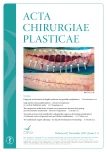Editorial
Published in the journal:
ACTA CHIRURGIAE PLASTICAE, 65, 3-4, 2023, pp. 97
Dear readers,
we are meeting over the current double issue of Acta chirurgiae plasticae in the era of dynamic changes affecting not only the system and organization of health care, but also the development of new technologies. These are gradually being applied in individual medical disciplines, including maxillofacial surgery. According to recent statistical analyses, it appears that shortly we will have to face an increased demand for curative and preventive care in the context of the expected increase in morbidity in the ageing population, which will contrast with the limited availability of staff resources, among both medical and non-medical health professionals. Each discipline certainly has its own specificities in this regard, but given the multidisciplinary nature of contemporary medicine, problems in one segment of care will inevitably have an impact on the work of all the other specialties involved. Not only Czech healthcare is thus in a state of searching for a way to an effective and financially sustainable system in order to prevent the deterioration of access to care, which cannot be done without the necessity of early restructuring and optimisation of organisational processes and education. So, this period may be called the time of high expectations.
Even from a professional point of view, contemporary maxillofacial surgery, like other surgical disciplines, are affected by revolutionary changes that make the work of surgeons easier and benefit our patients. We can observe a tendency towards individualisation of treatment procedures and personalized medicine, as well as the drive for greater precision and safety in surgery with preference for less invasive approaches and operating time reduction.
While some technological practices have already become a common part of our practice, others are part of our bright prospects. Increasingly, digitalisation using 3D technology in patient examination and surgical planning, the manufacture and use of patient-specific cutting guides, drilling templates and implants, intraoperative navigation and robotic surgery are being adopted. New tissue engineering techniques, including 3D bioprinting, may continue to change the view of reconstructive surgery beyond the orofacial region. Artificial intelligence algorithms, with their capabilities to learn, classify, predict and detect, will then appropriately complement human skills and reduce our imperfections. This may assist surgeons in finding the proper diagnosis and in their therapeutic decisions as well as in preoperative planning or in predicting and evaluating treatment outcomes.
Thus, in this turbulent time, I wish you an enjoyable reading of present double issue containing nine articles of varied focus, dealing with the treatment of various pathological lesions of the head and neck, the history and development of 3D maxillofacial surgery planning, the management of complications not only in orthognathic and reconstructive surgery, innovative approaches to defect closure after fasciotomy, and a comparison of different surgical techniques in prophylactic mastectomy.
Finally, the editorial board would like to apologize all authors for the extended review process caused by the introduction of the new editorial system.
Assoc. Prof. Lukáš Hauer, MD, DMD, PhD
Štítky
Chirurgia plastická Ortopédia Popáleninová medicína TraumatológiaČlánok vyšiel v časopise
Acta chirurgiae plasticae

2023 Číslo 3-4
- Metamizol jako analgetikum první volby: kdy, pro koho, jak a proč?
- Fixní kombinace paracetamol/kodein nabízí synergické analgetické účinky
- Antidepresivní efekt kombinovaného analgetika tramadolu s paracetamolem
- Geriatrická křehkost a léčba bolesti
- Kombinace metamizol/paracetamol v léčbě pooperační bolesti u zákroků v rámci jednodenní chirurgie
Najčítanejšie v tomto čísle
- Diagnosis and treatment of Eagle’s syndrome and possible complications
- Avascular necrosis of the maxilla after orthognathic surgery, a devastating complication? A systematic review of reported cases and clinical considerations
- 3D maxillofacial surgery planning – one decade development of technology
- Skin grafting on amputated lower limb, norepinephrine-induced ischemic limb necrosis – case report
